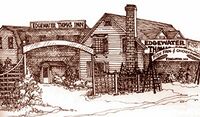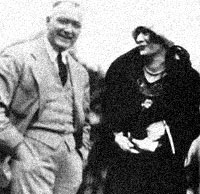Difference between revisions of "The Rendezvous, television series pitch/Episode loglines"
| Line 13: | Line 13: | ||
Respecting life, sacrifice, and a diamond treasure, '''''[[The Rendezvous, television series pitch|The Rendezvous]]''''', a dramatic television series, centers around a fictional Black family's circumstances and drama across three generations working at a local historical roadhouse through three Windsor-Detroit intense events - [https://en.wikipedia.org/wiki/Rum-running rum-running] of the 1920s, war-time [https://en.wikipedia.org/wiki/1943_Detroit_race_riot riots of 1943], and the "peace"-time [https://en.wikipedia.org/wiki/1967_Detroit_riot riots of 1967] in "Motown". Without being preachy or pedantic, issues like prejudice, domestic abuse, organized crime, fairness and ethics, personal autonomy, musical trends, and motor vehicles are fairly addressed and dramatized in evolving morals and culture across the decades. | Respecting life, sacrifice, and a diamond treasure, '''''[[The Rendezvous, television series pitch|The Rendezvous]]''''', a dramatic television series, centers around a fictional Black family's circumstances and drama across three generations working at a local historical roadhouse through three Windsor-Detroit intense events - [https://en.wikipedia.org/wiki/Rum-running rum-running] of the 1920s, war-time [https://en.wikipedia.org/wiki/1943_Detroit_race_riot riots of 1943], and the "peace"-time [https://en.wikipedia.org/wiki/1967_Detroit_riot riots of 1967] in "Motown". Without being preachy or pedantic, issues like prejudice, domestic abuse, organized crime, fairness and ethics, personal autonomy, musical trends, and motor vehicles are fairly addressed and dramatized in evolving morals and culture across the decades. | ||
| − | The following episode outlines combined together may be considered the overarching series treatment or an alternative 2024 treatment for [[The Rendezvous, screenplay|''The Rendezvous'', screenplay]]. | + | The following episode outlines combined together may be considered the overarching series treatment - and/or an alternative 2024 treatment for [[The Rendezvous, screenplay|''The Rendezvous'', screenplay]]. |
== Work in progress == | == Work in progress == | ||
Revision as of 01:34, 22 July 2024
Based on The Rendezvous, an unpublished feature screenplay by Jason Carswell.
A logline (aka elevator pitch) is a one or two line plot summary.
First, the overarching series logline:
Respecting life, sacrifice, and a diamond treasure, The Rendezvous, a dramatic television series, centers around a fictional Black family's circumstances and drama across three generations working at a local historical roadhouse through three Windsor-Detroit intense events - rum-running of the 1920s, war-time riots of 1943, and the "peace"-time riots of 1967 in "Motown". Without being preachy or pedantic, issues like prejudice, domestic abuse, organized crime, fairness and ethics, personal autonomy, musical trends, and motor vehicles are fairly addressed and dramatized in evolving morals and culture across the decades.
The following episode outlines combined together may be considered the overarching series treatment - and/or an alternative 2024 treatment for The Rendezvous, screenplay.
Work in progress
Rather than directly adapt The Rendezvous screenplay, an unpublished feature screenplay by Jason Carswell, after many years of not looking at my script or copious notes I'm going to first outline (and maybe draft a treatment of) the story, in part from memory yet new in part, to fit this series format and dramatically limit the number of settings (and in preparation for a stage play version), to see what new gems may turn up before polishing begins.
At present, 12 or 13 episodes of about 10 minutes each (plus credits), would add up to 120 to 130 minutes - like a movie, but not.
Historical accuracy
Great care was taken to have as few anachronisms as possible in developing The Rendezvous screenplay. In developing this television series we should try too, but may find more liberty in the oldest third taking place between 1922 and 1929, undefined by not mentioning dates or current events.
The road now known as Riverside Drive East would have been a primitive road until it evolved from dirt to gravel then its current Tarmacadam surface, as would the road surface markings. Further local timeline research is required to apply to this story's three eras. Similarly, the interior and exterior of The Rendezvous Tavern evolved over time, as did the owners.
Copyrights
- Jason Carswell grew up on Lake St. Clair at 11080 Riverside Drive, half-way between Sand Point Beach and The Rendezvous Tavern at the border of Windsor and Tecumseh, Ontario (across the lake from Grosse Pointe).
- Jason Carswell developed this story over decades into this original fictional story based in a lot of anecdotal and factual research.
- Jason Carswell is obviously sharing this story online on his Projex.Wiki website.
- Jason Carswell does not have an army of lawyers to protect this intellectual property.
- Jason Carswell requests that anyone who "borrows" elements or further develops his content would contact and include him in their projects, lucrative or not.
☑ Episode 1 - Sinking (1922)
From the blustery winter outdoors, boys burst into The Rendezvous roadhouse tavern with alarming news.
Venturing out onto the frozen Lake St. Clair, the men and boys find a stuck old jalopy weighed down with whisky perilously in danger of plunging into the frozen depths.
Despite several attempts with different ideas, the subtle and not-so-subtle racist men in various states of sobriety finally free the vehicle to continue its smugglers' journey - thanks to the clever logical ideas of Cliff, the Black employee of The Rendezvous.
Through the door, "You won't believe what happened..."
☑ Episode 2 - Inciting (1943)
Through the door, "You won't believe what happened..."
We follow Cliff and Clay as they weave through the animated discussions at The Rendezvous. Topics include the ongoing world war, rising tensions at home, the many variables, circumstances, and escalating problems, as well as unfounded rumours circulating.
Some lads invite Clay to go along on a trip to Belle Isle to see first hand what all the hubbub is about. "Pack for war. Not that war."
Cliff insists he go along, just in case...
☐ Episode 3 - Grinding (1967)
- Auto grind
-
+ cliffhanger
Episode 4 - Conflicting (1922, 1943, 1967)
☑ Episode 4a - Arguing (1922)
At home, Cliff's wife, Rose, incessantly challenges his manhood for failing to better stand up to the racists and get a pay raise.
"Why did I even tell you?..." Tensions rise.
She clips him with a cast iron pan and his response begins by smashing her head that creates a large hole in the kitchen wall as their children witness in horror.
Ruby, the girl and Clay, the boy...
☑ Episode 4b - Dishing (1943)
Clay, the man...
...is being assaulted at home by his pregnant wife, furious that he's off "to have fun picking fights in another country" leaving her alone, suffering.
Tensions rise. Dishes fly and smash. Punches fly. Cliff steps in, "Be a better father, man, than I was."
Clay, the man...
☐ Episode 4c - Denying (1967)
Clay, the old man...
-
+ cliffhanger
☑ Episode 5 - Warning (1922)
Touring musician Fats Waller is tickling the ivories at The Rendezvous as patrons drink.
Some fellas are setting up an important meeting that will soon take place at The Rendezvous.
"So I says to him, I says, 'Handy to be so near the river's current that'll sweep away your trash.' You see?"
Peter and Clay come down from the upstairs lookout to announce the looming arrival of police, but folks wonder if they're just saying that for the reward of fries - and then the wire-light alarms everyone into panic mode.
☐ Episode 6 - Tensing (1943)
- Having a riot
-
+ cliffhanger
☐ Episode 7 - Frustrating (1967)
- Seeds of discontent
-
+ cliffhanger
Episode 8 - Drinking (1922, 1943, 1967)
☑ Episode 8a - Misbehaving (1922)
Everyone pitches in to clean up and the entire bar rotates to hide the blind pig in the wall as the fellas manage an unnoticed getaway.
Fats starts adlibbing what would become one of his famous tunes [The 1929 Ain't Misbehavin' will enter the American public domain on January 1, 2025.], as the police enter asking knowing questions that are only rewarded with fries, like the boys, along with a subtle bribe.
☐ Episode 8b - Heartbreaking (1943)
- Patriarch ache
-
+ cliffhanger
☐ Episode 8c - Singing (1967)
[Post-cliffhanger]
"You Keep Me Hangin' On, from the girls about Motown. Thank you! Folks, The Supremes will take a short break and be back with Love Is Here and Now You're Gone
- Featuring three group members who were marketed for their individual personalities (a move unprecedented at the time) and Diana Ross's pop-friendly voice, the Supremes broke down racial barriers with rock and roll songs underpinned by R&B stylings. - In early 1967, the name of the act was officially changed briefly to "the Supremes with Diana Ross" before changing again to "Diana Ross & the Supremes" by mid-summer. - By 1967, Ballard would not show up for recording dates, or would arrive at shows too inebriated to perform. For some early 1967 shows, she was replaced by Marlene Barrow (a member of the Motown backup group The Andantes). - On June 29, 1967, the group returned to the Flamingo Hotel in Las Vegas as "Diana Ross & the Supremes". The first two days of the Flamingo engagement went by smoothly. On July 1, when reporting for makeup and wardrobe before their first show of the evening, Ballard discovered an extra set of gowns and costumes that had been brought along for Cindy Birdsong. Angered, Ballard performed the first concert of the night inebriated, leading to an embarrassing on-stage incident in which her stomach was revealed when she purposely thrust it forward during a dance routine. Enraged, Gordy ordered her back to Detroit and permanently dismissed her from the group. Birdsong officially assumed her place during the second July 1 show.
- "I saw you win the Freedom Fest in '60!" "They performed supremely." - Pun: "You can't hurry, love." - Future hits: "Love Child", "Ain't No Mountain High Enough", "Do You Know Where You're Going To?"
-
[Cliffhanger closing with The Supremes...]
"And now - their newest track, out any day now... Reflections!"
☐ Episode 9 - Thriving
- Optional 1800s bonus episode.
- Reflections echoes - Family tree -
+ cliffhanger
☐ Episode 10 - Tanking (1967)
- Tanks in Detroit
- Tanks a lot
-
+ cliffhanger
☐ Episode 11 - Lamenting (1943)
- Father's funeral
-
+ cliffhanger
☐ Episode 12 - Rendezvousing (1922)
- Gangsters rendezvous
-
+ cliffhanger
Episode 13 - Generating (1922, 1943, 1967)
☑ Episode 13a - Healing (1922)
Through the soft thick snowfall Cliff trudges home alone, in the dark.
Cliff finishes patching up the wall, he quietly tidies the kitchen, and puts his tools away.
Cliff slips into bed, Rose rolls over, and they embrace in silence.
Sins are forgiven.
☐ Episode 13b - Enriching (1943)
- awaken
- Real riches
-
+ cliffhanger
☐ Episode 13c - Shining (1967)
- Diamonds!
-
+ cliffhanger
Reference
Wikipedia links, unless otherwise noted:
1922
- Ain't Misbehavin' (song)
- "Ain't Misbehavin'" is a 1929 stride jazz/early swing song. Andy Razaf wrote the lyrics to a score by Thomas "Fats" Waller and Harry Brooks for the Broadway musical comedy play Connie's Hot Chocolates (opened June 20, 1929). As a work from 1929 with its copyright renewed, it will enter the American public domain on January 1, 2025.
- Boardwalk Empire, an HBO television series, 2010-2014
- Diamond#Gem-grade diamonds, are a controlled centralized trade artificially inflating the value of a semi-precious gem through marketing
- De_Beers#Marketing, 'A Diamond is Forever', 1947
- Diamonds Are a Girl's Best Friend, song in Gentlemen Prefer Blondes the 1949 musical and 1953 movie
- Diamonds Are Forever (1956 novel)
- Diamonds Are Forever (1971 film)
- De_Beers#Marketing, 'A Diamond is Forever', 1947
- Jewish-American organized crime
- Joseph Zerilli
- Meyer Lansky, oddly doesn't mention anything about his government and CIA connections
- Murder, Inc.
- Racketeering
- The Purple Gang, aka Sugar House Gang
- Prohibition#North America
- Prohibition in Canada
- Prohibition in the United States
- Rum-running
- Speakeasy, aka blind pig or blind tiger
- Teetotalism
- Riverside, Ontario#Historical and the Grand Taverns of Riverside:
- Edgewater Thomas Inn
- Island View Tavern (known as Abars)
- Lauzon Stop House
- Menard's Tavern
- Rendezvous Tavern
- Wolf's Hotel
- Pub#Roadhouse
1943
- 1943 Detroit race riot, Sunday June 20 - Tuesday June 22, 1943
- Belle Isle Park
- MacArthur Bridge (Detroit), 1923+, replaced an iron bridge with wooden decking that accidentally caught fire and was destroyed in 1915. The bridge, popularly known as the Belle Isle Bridge, was originally named the George Washington Bridge and renamed the Douglas MacArthur Bridge after General Douglas MacArthur in 1942.
- Detroit Diesel Series 71, 1938–1995
- Fats Waller, 1904 - 1943-12-15
- Harry Houdini#Death, (1874 - Halloween 1926)
- Naval Air Station Grosse Ile, 1929 - 1969
1967
- 1967 Detroit riot, Sunday July 23, 1967 - Thursay July 27, 1967, aka The 12th Street Riot
- "Black Day in July" – 4:10 - Side 1, Track 3 on the album: Did She Mention My Name?
- By Gordon Lightfoot on YouTube
- Covered by The Tragically Hip on YouTube
- "Black Day in July" – 4:10 - Side 1, Track 3 on the album: Did She Mention My Name?
- Civil rights movement, 1954 - 1968
- Civil rights movement in popular culture
- List of civil rights leaders
- Malcolm X, 1925 - 1965-02-21
- Martin Luther King Jr., 1929 - 1968-04-04
- List of peace activists
- Detroit Renaissance
- Renaissance Center, 1973 - 1977+
- The Supremes
- The Supremes#Impact
- Diana Ross & the Supremes: The No. 1's
- (1964-06-17) Where Did Our Love Go #1
- (1964-09-17) Baby Love #1
- (1964-10-27) Come See About Me #1
- (1965-02-08) Stop! In the Name of Love #1
- (1965-04-15) Back in My Arms Again #1
- (1965-10-06) I Hear a Symphony #1
- (1966-07-25) You Can't Hurry Love #1
- (1966-10-12) You Keep Me Hangin' On #1
- (1967-01-11) Love Is Here and Now You're Gone #1
- (1967-03-20) The Happening (song) #1
- (1967-07-24) Reflections (The Supremes song) #2
- (1968-09-30) Love Child (song) #1
- (1968-11-21) I'm Gonna Make You Love Me #2
- (1969-06-13) Someday We'll Be Together #1
- (1970-10-15) Stoned Love #7
- (1970-07-16) Ain't No Mountain High Enough #1
- (1973-05-03) Touch Me in the Morning (song) #1
- (1975-09-24) Theme from Mahogany (Do You Know Where You're Going To) #1
- Detroit dramas
- Detroit history
- Filmmaking
- Historical drama
- Independent media
- Loglines
- Media alternatives
- Media ideas
- Media projects
- Original content
- Pitches
- Production development
- Projects started on 2023-03-06
- Stories set in the 1920s
- Stories set in the 1940s
- Stories set in the 1960s
- Television
- Television series pitches
- The Rendezvous
- The Rendezvous, television series pitch
- Windsor communications
- Windsor dramas
- Windsor dramatic productions
- Windsor entertainment
- Windsor history
- Windsor indie-media
- Windsor media
- Windsor prepper projects
- Windsor video productions
- Windsor videos




